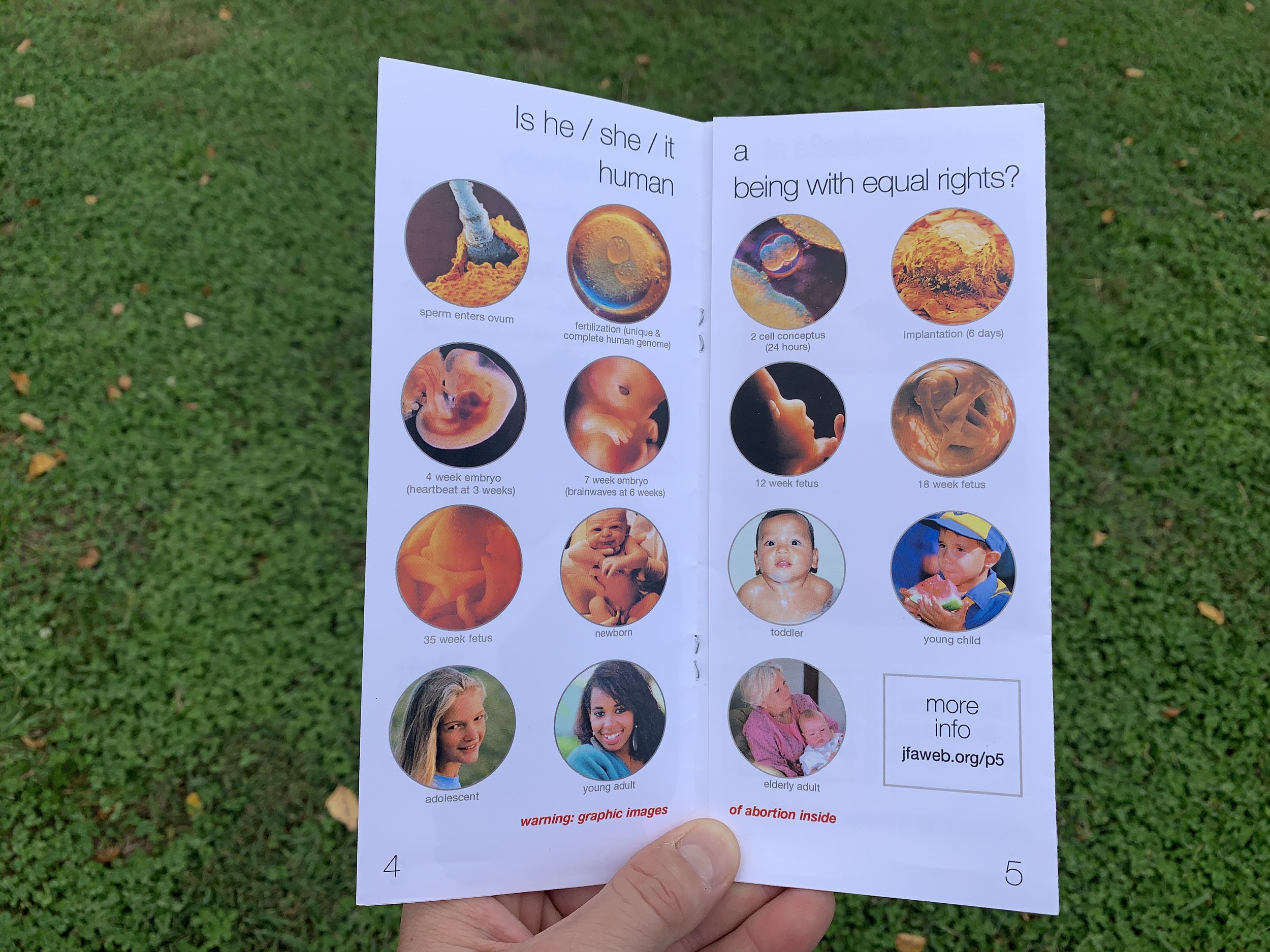Tammy (left) and Rose (in red) talk with Chase at WSU in September 2021.
What a wonderful fall semester! It has been such a joy to be back on campus and having in-person conversations with students. I participated in JFA events in Kansas, Colorado, and Oklahoma. At a small campus outreach event at Wichita State University (WSU) in September, I had a memorable conversation with a student that lasted nearly an hour. I think you’ll be delighted at the outcome.
I was standing with Rose, JFA intern, in front of our Should Abortion Remain Legal poll sign. We met a student named Chase. He didn’t sign our poll, but instead asked our opinion. So I briefly explained our pro-life view. He said that he would vote yes because people are going to do it anyway and we should keep it safe. I asked if he was pro-choice, and he said yes.
Seeking to find common ground I asked, “Should it be legal when done for sex selection? As a form of birth control? During the late term?” He didn’t think it should be legal for any of those reasons. I remarked that there’s a lot on which we agree. He smiled and shook his head affirmatively.
“Invitation to Dialogue” Brochure, pp. 4-5 (Get your own copy here.)
I began explaining the JFA “Invitation to Dialogue” Brochure. I gave a summary of basic human reproduction and biology on the pages depicting stages of human life, before and after birth. He agreed that the unborn is a developing human at fertilization, but it needs a heartbeat to be a human being.
I agreed there is no heartbeat during the first three weeks. I explained that the unborn is a developing human organism, and there’s no injection of essential genetic material after fertilization. The unborn only needs one thing to continue its development—nutrition. And that’s all that we need to move through the stages of human life, from birth to toddler, to teenager, to young adult, etc. We are the same whole human organism at fertilization as we are right now. He agreed that that made sense.
After a short pause, he said, “If that’s all true, then abortion might be wrong depending on the circumstance.” Wow, progress!
I was enjoying this conversation with Chase, not because he was agreeing with everything that I was asking or saying (he wasn’t), but because we built a rapport rather quickly. He pushed back often, which I fully expected from someone that says he is pro-choice. It was exciting to be on a journey engaging with someone who is open-minded and using critical thinking skills. Chase found it surprising, for example, when I noted that about 95% of abortions are for reasons other than rape, life of the mother, and incest.
My next step was using the Equal Rights Argument. I asked what is the same about us—what gives us our equality? He said that the ability to think is what gives us our equality. I asked him to consider a scenario. If the three of us took the same physics test, how would each of us do? I said that I probably wouldn’t do very well. Rose said she wouldn’t do well either, but Chase said that he would do well. I responded, “Since it’s obvious that we have different levels of the ability to think, then our ability to think can’t be the ‘thing’ that gives us our equality because we don’t all think equally, right? Doesn’t our equality have to be based on something that we all have equally?” He shook his head yes and I sensed this was a lightbulb moment. I continued, “I believe that our humanness is what’s the same about all of us—that’s what gives us our equality. And since the unborn are human like us, don’t they deserve to be treated equally to us?” He nodded in agreement. More progress.
Since Chase had referenced personal freedoms several times, I knew that was an important topic to him. So I shared my Two Buckets analogy. At the end of my story, I asked, “In which bucket does abortion belong? Does it belong in the one with personal preferences or the one with things like murder and stealing?” He thought for a minute and said, “I’m against 95% of abortions. That 95% belongs in the bucket with murder. I can now see that abortion is wrong. But abortion needs to be legal for the other 5%.” Praise God! Now I’m going after that remaining 5%!
I agreed that rape, incest, and life of the mother are very tough situations. I addressed each circumstance and expressed concern for those women. I commended Chase for his compassion. After I felt that I had adequately communicated my compassion, I attempted to bring the conversation back to the point of agreement that the unborn is human. I “trotted out a toddler.” I said, “Imagine a woman with a two-year-old who was conceived in rape. Would you agree that she can’t kill her child even though she can’t deal with the deep emotional pain she feels every time she looks at her child?” He agreed. We discussed it further and agreed that even though the topic of rape is very difficult, that since the unborn is human like the two-year-old, then we can’t kill the unborn in the same way that we can’t kill the two-year-old. They are both valuable human beings.
I added a few more facts. I told him that many people don’t know there are a lot of resources available at thousands of Pregnancy Resource Centers. I said there are about 2,500 abortions every day and I believe there are plenty of resources to help every one of those women.
He said, “Okay, you convinced me! I’m against abortion 100%!” We looked at each other with big smiles and high-fived! Then he signed “No” on our Should Abortion Remain Legal poll. Praise God!
For help learning and using the tools that I employed in my conversation with Chase, here’s a special list of links just for you:
Trot Out the Toddler (Collection of Newsletters by JFA Trainers)
Equal Rights Argument (Collection of Newsletters by JFA Trainers)
Thank you for your prayers and for your continued support. I’m experiencing a shortfall in my support right now. Would you consider giving a special year-end gift to help? Thank you! May God bless you.
In Christ,
Tammy Cook



